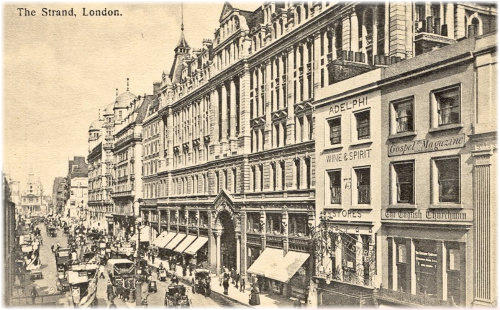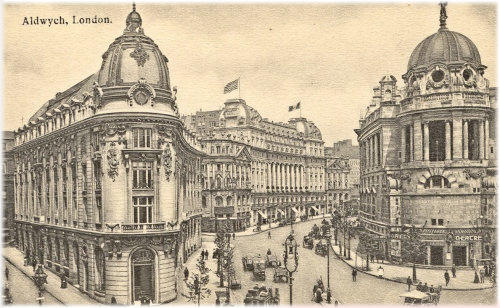Now and Then - London
Londinium was established as a civilian town by the Romans about seven years after the invasion of AD 43.
London, like Rome, was founded on the point of the river where it was narrow enough to bridge and the strategic location of the city provided easy access to much of Europe.
Early Roman London occupied a relatively small area, roughly equivalent to the size of Hyde Park. In around AD 60, it was destroyed by the Iceni, a Brittonic tribe of eastern Britain, led by their queen Boudicia The city was quickly rebuilt as a planned Roman town and recovered after perhaps 10 years, the city growing rapidly over the following decades.
London, like Rome, was founded on the point of the river where it was narrow enough to bridge and the strategic location of the city provided easy access to much of Europe.
Early Roman London occupied a relatively small area, roughly equivalent to the size of Hyde Park. In around AD 60, it was destroyed by the Iceni, a Brittonic tribe of eastern Britain, led by their queen Boudicia The city was quickly rebuilt as a planned Roman town and recovered after perhaps 10 years, the city growing rapidly over the following decades.
The Strand
The road's name comes from the Old English strond, meaning the edge of a river, as it historically ran alongside the north bank of the River Thames. The street was popular with the British upper classes between the 12th and 17th centuries, with many historically important mansions being built between the Strand and the river.The street is the main link between the two cities of Westminster and London.
The road's name comes from the Old English strond, meaning the edge of a river, as it historically ran alongside the north bank of the River Thames. The street was popular with the British upper classes between the 12th and 17th centuries, with many historically important mansions being built between the Strand and the river.The street is the main link between the two cities of Westminster and London.
Aldwych
In the seventh century, an Anglo-Saxon village and trading centre named Lundenwic ('London trading town') was established approximately one mile to the west of Londinium in what is now Aldwych. The old site of Londinium became known as Lundenburh, and Lundenwic was mostly abandoned and became known as Ealdwic (meaning 'old trading town' or 'old marketplace'). The name was recorded as Aldewich in 1211
In the seventh century, an Anglo-Saxon village and trading centre named Lundenwic ('London trading town') was established approximately one mile to the west of Londinium in what is now Aldwych. The old site of Londinium became known as Lundenburh, and Lundenwic was mostly abandoned and became known as Ealdwic (meaning 'old trading town' or 'old marketplace'). The name was recorded as Aldewich in 1211
Birds eye view from St Brides Church
St Bride's Church is a church in the City of London. The building's most recent incarnation was designed by Sir Christopher Wren in 1672 in Fleet Street in the City of London, though Wren's original building was largely gutted by fire during the London Blitz in 1940. Due to its location in Fleet Street, it has a long association with journalists and newspapers. The church is a distinctive sight on London's skyline and is clearly visible from a number of locations.
St. Bride's may be one of the most ancient churches in London, with worship perhaps dating back to the conversion of the Middle Saxons in the 7th century. It has been conjectured that, as the patron saint is St Bridget of Ireland, it may have been founded by Celtic monks, missionaries proselytising the English. The present St Bride's is at least the seventh church to have stood on the site
St Bride's Church is a church in the City of London. The building's most recent incarnation was designed by Sir Christopher Wren in 1672 in Fleet Street in the City of London, though Wren's original building was largely gutted by fire during the London Blitz in 1940. Due to its location in Fleet Street, it has a long association with journalists and newspapers. The church is a distinctive sight on London's skyline and is clearly visible from a number of locations.
St. Bride's may be one of the most ancient churches in London, with worship perhaps dating back to the conversion of the Middle Saxons in the 7th century. It has been conjectured that, as the patron saint is St Bridget of Ireland, it may have been founded by Celtic monks, missionaries proselytising the English. The present St Bride's is at least the seventh church to have stood on the site
Ludgate Hill
Ludgate Hill is a hill in the City of London, near the old Ludgate, a gate to the City that was taken down, with its attached gaol, in 1780. It is the site of St. Paul's Cathedral, traditionally said to have been the site of a Roman temple of the goddess Diana. It is one of the three ancient hills of London, the others being Tower Hill and Cornhill. The highest point is just north of St. Paul's.
Ludgate Hill is a hill in the City of London, near the old Ludgate, a gate to the City that was taken down, with its attached gaol, in 1780. It is the site of St. Paul's Cathedral, traditionally said to have been the site of a Roman temple of the goddess Diana. It is one of the three ancient hills of London, the others being Tower Hill and Cornhill. The highest point is just north of St. Paul's.
Thames Embankment
The Thames Embankment is a work of 19th-century civil engineering that reclaimed marshy land next to the River Thames in central London. It consists of the Victoria Embankment and Chelsea Embankment. Embankments along the Thames were first proposed by Christopher Wren in the 1660s.
Started in 1862, the present embankment on the northern side of the river was primarily designed by Sir Joseph Bazalgette. Some parts of the Embankment were built in the twentieth century, having been reconstructed following wartime bomb damage or natural disasters such as the 1928 Thames flood.
The Thames Embankment is a work of 19th-century civil engineering that reclaimed marshy land next to the River Thames in central London. It consists of the Victoria Embankment and Chelsea Embankment. Embankments along the Thames were first proposed by Christopher Wren in the 1660s.
Started in 1862, the present embankment on the northern side of the river was primarily designed by Sir Joseph Bazalgette. Some parts of the Embankment were built in the twentieth century, having been reconstructed following wartime bomb damage or natural disasters such as the 1928 Thames flood.

Proudly powered by Weebly














